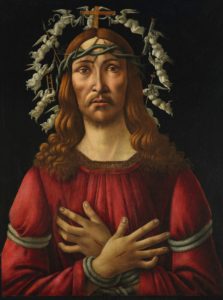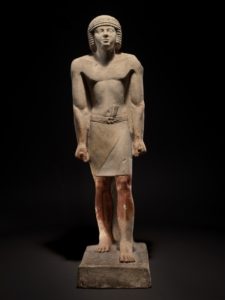There was a bit of excitement about the Thursday morning January 27th Old Masters sale at Sotheby’s. This was mainly because of Sandro Botticelli’s Christ portrait known as the Man of Sorrows. Previously, I had written about the painting, namely its rarity and how scans showed another work underneath the paint. But the actual auction proved less exciting than expected.
The auctioneer came across as unnecessarily slow and cautious right off the bat. He seemed hesitant to bang the gavel on most lots, causing me to scream “Go!” at my computer screen more than once. Giovanni Bellini’s Madonna and Child at a Ledge with an Apple passed with a final bid of $2.9 million. Yet it seemed like the auctioneer lingered at that bid for a solid two or three minutes, saying “Fair warning” twice in the process (maybe because of stress or maybe ineptitude). I felt like I could’ve walked the twenty blocks to Sotheby’s and banged the gavel myself quicker than he did most of the time.
But when the big-ticket item finally came up, it sadly fell just a little short. The Botticelli brought in $39.3 million (or $45,190,700 w/p), just shy of the $40 million estimate. Not an insignificant price, but not what many were expecting. Confusingly, the rap of the gavel was met with a round of applause, perhaps a little undeserved. It’s not like it went for an exponentially higher dollar amount or anything.
Old Masters sales can sometimes serve as a moment to teach everyone an important lesson. The title of Old Master doesn’t always mean you’re going to like the painting. I first became aware of this reality during the sale when Fra Diamante’s Madonna and Child with Three Angels came up. Two of the five figures have faces too small for their heads, while the Christ Child was given a set of legs more appropriate for the Michelin Man. Furthermore, I was baffled to see a $4.5 million estimate on a painting by Correggio, mainly because of the appearance and the size. Saint Mary Magdalen Reading is strange since the subject saint is confusingly dressed in a dark robe against a dark background, making it difficult to see what you’re even looking at. Also, the painting without the frame is barely even 9 inches by 11 inches. Now, the multimillion-dollar estimate could be excused by the painting’s recent rediscovery. Before coming to auction, experts only knew about the Correggio Magdalen because of copies by other artists. Otherwise, it was considered a lost masterwork.
But the sale wasn’t entirely without highlights. Francisco de Goya’s Portrait of the Marquis de Caballero is very typical of the Spanish master’s portraits in playing with light and texture and creating displays of power. It reached triple its high estimate with a hammer price of $1.8 million (or $2,198,000 w/p). Furthermore, the Dutch painter Quiringh van Brekelenkam did very well with another one of his looks into Dutch domestic life with The Lacemaker’s School. It brought in more than double its $150,000 estimate. Finally, the most unexpected of the highlights came in the form of a seemingly out-of-place ancient Egyptian statue. The 4,000-year-old limestone figure was fascinating to find in this sale specifically. I mean, I know it's an Old Master sale, but this is undoubtedly a little too old. But the statue did very well, far exceeding its estimate and reaching $8.4 million (or $9,915,600 w/p). Though not an Old Master work, it ended up reaching the second-highest hammer price of the sale.
While the Sotheby’s saleroom seemed to have a decently-sized crowd in attendance, there was undoubtedly a lack of enthusiasm. Despite a few highlights, the entire sale seemed a bit lackluster given the names attributed to the works. In total, the sale brought in $76 million hammer (or $91 million w/p), which is just barely past the total minimum estimate of $73.1 million. Many analysts have been saying for some time that interest in Old Masters has declined in recent years, especially among the younger buyers that have become such a powerful force in the market. While this Sotheby’s sale might serve as another unfortunate example of that phenomenon, Old Masters works aren’t exactly making nothing at auction. It’s likely this corner of the art world is just undervalued for the time being and will bounce back with the ebbs and flows of the market soon enough.



